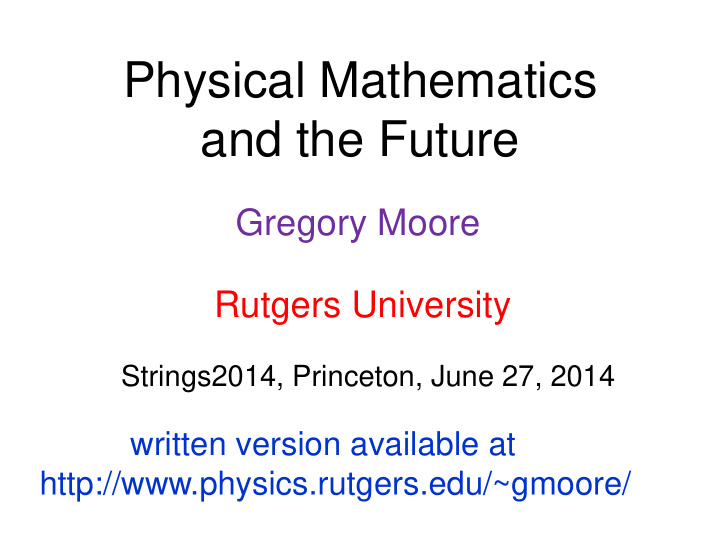



Physical Mathematics and the Future Gregory Moore Rutgers University Strings2014, Princeton, June 27, 2014 written version available at http://www.physics.rutgers.edu/~gmoore/
Hilbert’s Problem Set Who of us would not be glad to lift the veil behind which the future lies hidden; to cast a glance at the next advances of our science and at the secrets of its development during future centuries? What particular goals will there be toward which the leading mathematical spirits of coming generations will strive? What new methods and new facts in the wide and rich field of mathematical thought will the new centuries disclose?
1900: Hilbert’s 6 th Problem He stated his famous 23 problems for the 20 th century, on August 8, 1900 To treat […] by means of axioms, those physical sciences in which mathematics plays an important part […] October 7, 1900: Planck’s formula, introducing h.
If then, Herr Doktor Hilbert, who possessed such deep mathematical insight, could not read the simplest aspects of the quantum relativistic future in its profounder and more subtle meanings, how may unlettered Ishmael hope to read the awful Chaldee of String Theory’s future? I will do what little I can. One thing I can do is look to the past. Let us do so briefly so that I can explain the term ``Physical Mathematics’’
Snapshots from the Great Debate over Kepler Galileo the relation between Mathematics and Physics Newton Leibniz
When did Natural Philosophers become either physicists or mathematicians? Even around the turn of the 19 th century … But, we can read in volume 2 of the journal Nature ….
1869: Sylvester’s Challenge A pure mathematician speaks:
1870: Maxwell’s Answer An undoubted physicist responds, Maxwell recommends his somewhat-neglected dynamical theory of the electromagnetic field to the mathematical community:
1897: The First ICM
1931: Dirac’s Paper on Monopoles
1972: Dyson’s Announcement
Well, I am happy to report that Mathematics and Physics have remarried! But, the relationship has altered somewhat… A sea change began in the 1970’s …..
A number of great mathematicians got interested in the physics of gauge theory and string theory, among them, M. Atiyah I. Singer R. Bott G. Segal
And at the same time a number of great physicists started producing results requiring increasing mathematical sophistication, among them S. Coleman B. Zumino We know who many of you in the audience… you are!
Physical Mathematics With a great boost from string theory, after 40 years of intellectual ferment a new field has emerged with its own distinctive character, its own aims and values, its own standards of proof. One of the guiding principles is certainly Hilbert’s 6 th Problem (generously interpreted): Discover the ultimate foundations of physics. As predicted by Dirac, this quest has led to ever more sophisticated mathematics… But getting there is more than half the fun: If a physical insight leads to an important new result in mathematics – that is considered a great success. It is a success just as profound and notable as an experimental confirmation of a theoretical prediction.
Strings vs. String-Math This is a world in which each of us, knowing his limitations, knowing the evils of superficiality and the terrors of fatigue, will have to cling to what is close to him, to what he knows, to what he can do, …
Future Directions
List of concrete problems at: http://www.physics.rutgers.edu/~gmoore/ PhysicalMathematicsAndFuture.pdf
Some QFT's have no action principle and no obvious``fundamental'' degrees of freedom. Some QFT's have many action principles with totally different ``fundamental'' degrees of freedom. Even with an action principle, mathematical construction of interacting QFT with running couplings is hard. S-matrix amplitudes display much magic, encoding locality in unusual ways.
There are ``theories’’ which are neither local QFT’s nor fully string theories: Little string theory, brane probe theories, noncommutative field theories,… Many nontrivial field theoretic phenomena have simple geometrical reformulations (using compactification and branes) Fully local theories should have gluing rules for all codimensions. Field theories are not fully defined without specifying their categories of defects.
All this evidence suggests that there are new, possibly more geometric, ways of formulating Quantum Field Theory Possibly one way forward would be to find a general conceptual mathematical framework for the AdS/CFT correspondence.
I cannot forecast what stormy weather our field is destined to endure, but I can forecast with confidence that there will be abundant moonshine ahead.
Enduring Question: M-Theory
D-branes teach us to replace spacetime with D-brane categories. Space- time becomes noncommutative…
Recommend
More recommend